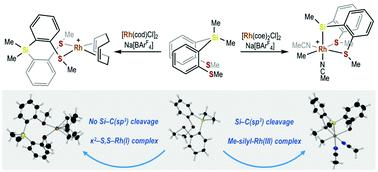当前位置:
X-MOL 学术
›
Dalton Trans.
›
论文详情
Our official English website, www.x-mol.net, welcomes your feedback! (Note: you will need to create a separate account there.)
Si-C(sp3) bond activation through oxidative addition at a Rh(i) centre.
Dalton Transactions ( IF 4 ) Pub Date : 2020-04-06 , DOI: 10.1039/d0dt00725k S Azpeitia 1 , A J Martínez-Martínez , M A Garralda , A S Weller , M A Huertos
Dalton Transactions ( IF 4 ) Pub Date : 2020-04-06 , DOI: 10.1039/d0dt00725k S Azpeitia 1 , A J Martínez-Martínez , M A Garralda , A S Weller , M A Huertos
Affiliation

|
An easy, direct and room temperature silicon-carbon bond activation is reported. The reaction of [RhCl(coe)2]2 with the silane Si(Me)2(o-C6H4SMe)2 in the presence of an halide extractor provokes a Si-CH3 bond cleavage yielding a cationic silyl-methyl-Rh(iii). In contrast, if the reaction is performed using the Rh(i) bis-alkene dimers, [RhCl(cod)]2 or [RhCl(nbd)]2, the Si-CH3 bond activation does not occur.
中文翻译:

Si-C(sp3)通过Rh(i)中心的氧化加成键活化。
据报道,容易,直接和在室温下进行硅-碳键活化。在卤化物萃取器的存在下,[RhCl(coe)2] 2与硅烷Si(Me)2(o-C6H4SMe)2的反应引起Si-CH3键裂解,产生阳离子甲硅烷基-甲基-Rh(iii) 。相反,如果使用Rh(i)双烯烃二聚体[RhCl(cod)] 2或[RhCl(nbd)] 2进行反应,则不会发生Si-CH3键活化。
更新日期:2020-03-23
中文翻译:

Si-C(sp3)通过Rh(i)中心的氧化加成键活化。
据报道,容易,直接和在室温下进行硅-碳键活化。在卤化物萃取器的存在下,[RhCl(coe)2] 2与硅烷Si(Me)2(o-C6H4SMe)2的反应引起Si-CH3键裂解,产生阳离子甲硅烷基-甲基-Rh(iii) 。相反,如果使用Rh(i)双烯烃二聚体[RhCl(cod)] 2或[RhCl(nbd)] 2进行反应,则不会发生Si-CH3键活化。



























 京公网安备 11010802027423号
京公网安备 11010802027423号